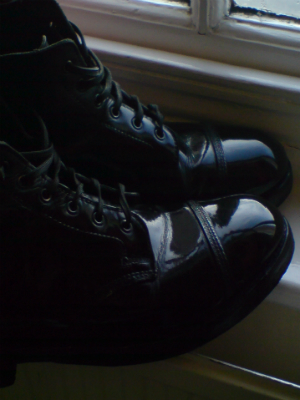Where is the garrison Army going? I worry it is heading back to spit and polish, while ignoring hard lessons of the last decade

By "58 Scout"
Best Defense guest columnist
The more we draw down from our current conflicts
the more of a push from the top I am seeing to become a more disciplined force.
Got it -- "always be better" -- but a lot of the comments that myself and many
of my peers keep hearing are quite disturbing and, to be honest, generally
insulting.
During my redeployment briefings we received a
video message from the U.S. Army Pacific Commander. In it was the typical "good
job, you are the country's finest, etc. etc.," but what really burned me, and
most of the men and women who watched the video, was one of the CG's comments. I
am paraphrasing, but it was something to the effect that "this is the best Army
I have seen in 30 years of service...but we need to take it back to pre-war Army."
Really?
The
final straw for me was this piece I found in the Army Times about SMA Chandler and his changes for the force. That article
is about sending CSMs to legal courses to do their jobs better, but again, the
intent is the same and getting louder.
Chandler
told the senior enlisted leaders to institute programs at their posts, camps,
and stations to apply lessons learned to the Profession of Arms
Campaign. The Profession of Arms has become a lost art, especially among
junior officers and NCOs. The deployment cycle of the past decade eroded
everything from common military courtesies to fitness standards. Of great concern
is the lack of counseling, leadership, and decision-making skills needed by
midgrade NCOs and junior officers.
I
am deeply concerned about just what he is trying to address. Yes, the garrison
Army will have more saluting, parade rest, clean uniforms, haircuts, etc., but
he has cut deeper. I'm confused -- what decision-making skills should the
combat proven SSG need to work on? And let's be honest: I don't think that the
SMA and most of the senior officers and NCOs have ever really walked in those
shoes. During these wars the decisions made by junior officers and NCOs, at the
company and platoon level, have been some of the most important. It makes me
angry because I know what I have done and what so many others like me have done
and more. The entire intent of being a professional soldier is going to war and
destroying the enemy. What most of us in the military have trained for -- and
done -- several times. Yes, there were a lot of growing pains over the
last decade, especially learning what was most important to accomplish this
task. We learned: Shooting, first aid, cultural lessons -- important! Haircuts,
hands in pockets, pressing uniforms? Not that important.
The
senior leaders of today's Army want to go back to the Army that they grew up in -- the Army of
the 80s and 90s, with the spit-polished boots, starched uniforms, skin-tight
haircuts. To them, these are the signs of a disciplined force. To the senior
leaders of the Army I say this: Bring back the tough and realistic training
standards that made us a focused and disciplined force. Those are the things that
will prepare the force for challenges that lie ahead in the decades to come. Incorporate
this training with the volumes of lessons learned in leadership and
decision-making, while under fire, by our junior officers and NCOs. The success
and failures of the next decade will be based on your leadership and decision-making
skills and how we cultivate our junior officers and NCOs.
I'm
not sure where this Army is going but I am deeply concerned. Maybe I'm
missing something that can only be seen from the top. Or maybe the SMA thinks
doing circles around the parade field will draw attention away from the fact
that we don't have any money for real combat training.
"58 Scout" is an active-duty
soldier.
Thomas E. Ricks's Blog
- Thomas E. Ricks's profile
- 436 followers



